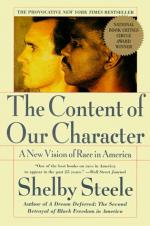|
This section contains 513 words (approx. 2 pages at 400 words per page) |

|
The Content of Our Character: A New Vision of Race in America Summary & Study Guide Description
The Content of Our Character: A New Vision of Race in America Summary & Study Guide includes comprehensive information and analysis to help you understand the book. This study guide contains the following sections:
This detailed literature summary also contains Topics for Discussion and a Free Quiz on The Content of Our Character: A New Vision of Race in America by Shelby Steele.
The Content of Our Character is written by author, columnist, and self-described black conservative Shelby Steele. Steele is currently a fellow at the Hoover Institute that studies race relations and affirmative action. The Content of Our Character won Steele the 1990 National Book Critics Circle Award for non-fiction. Born to a black father and a white mother, Shelby has a BA in political science, an MA in sociology, and a PhD in English. He was active in the Civil Rights movement and was a part of the black power movement.
The Content of Our Character turns a critical eye to how the black community has responded to the increased freedoms they won through the Civil Rights movement. While Steele believes that blacks still suffer from discrimination, he argues that they often give up opportunities staring them in the face because of fear and self-doubt. Blacks often blame society for their difficulties and social problems rather than taking initiative to meet their challenges head on. Blacks often react negatively to the bourgeois values that have helped other ethnic minorities withstand discrimination and achieve equality and advancement in American society.
The Content of Our Character is a short book, with an introduction, epilogue, and nine brief chapters. In Chapter 1, "I'm Black, You're White, Who's Innocent?" Steele argues that race is often used as a method of gaining power by both blacks and whites. In reality, race allows blacks and whites to shift what Steele calls "innocence" back and forth. Both sides employ racial power when they seek to alleviate their own guilt and play the victim.
Chapter 2, "Race-Holding" explains Steele's concept of race-holding where blacks often use their racial identity to protect their vulnerabilities but at the same time deprive themselves of important social opportunities. In Chapter 3, "Being Black and Feeling Blue," Steele argues that black identity is often reactionary and dependent on maintaining that American society is deeply racist and that the deck is stacked against blacks. Black identity also often restricts black individuality, blocking black advancement.
Chapter 4, "The Recomposed Self" makes the case that blacks have developed an identity based on "recomposition" or constructed an identity based on the struggles that blacks have engaged in. This identity is therefore reliant on blacks continuing to struggle and thereby harms blacks when they make real achievements. Chapter 5, "White Guilt" explains the idea of white guilt and how it figures into black identity.
Chapter 6, "On Being Black and Middle Class" focuses on the problems specific to being black and middle class. Chapter 7, "Affirmative Action" lays out Steele's critique of affirmative action and racial preferences. Chapter 8, "The Recoloring of Campus Life" describes the challenges blacks and whites face on college campuses specifically and Chapter 9, "The Memory of Enemies" describes how black memories of discrimination and the shame associated with it continues to hold blacks back. In the Epilogue, Steele lays out the challenges facing the black community and argues that if blacks avoid the barriers that a previously helpful sense of black identity has given them, that they can achieve advancement in American society.
Read more from the Study Guide
|
This section contains 513 words (approx. 2 pages at 400 words per page) |

|



